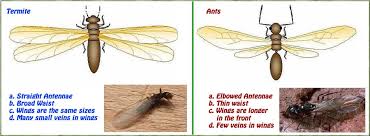Serving Memphis, Cordova, Germantown & Collierville TN
As spring arrives, hopefully for good this time, a lot of you will probably start working on the dreaded SPRING CLEANING project of getting your home ready for summer. Spring not only brings warmer temps and cleaning projects, it can also bring swarms of insects. Knowing the difference between FLYING ANTS & SWARMING TERMITES can save you both money and your sanity.
Trust me, I’ve talked to many “panicked” homeowners over the years as they worry that their biggest investment, their home, has just become “the hottest lunch spot in town for termites!”
Termites can cause over 5 billion dollars of damage per year, so being worried isn’t a stretch, but being ill informed can be costly, since termites eat 24 hours a day – 7 days a week. Misidentifying a swarming termite can allow time for termites to do some real damage.
You also need to understand that the swarmer’s aren’t actually doing the damage. The swarming termite’s main purpose is to reproduce and spread the colony. So if you do have a termite swarm feel confident that your home is at least a cool spot for single termites to meet and mingle, come on you know you always wanted to have the “cool house” where everyone liked to hang out.
Below I’ve listed some technical differences to look for, as well as a picture, but let’s be honest – you’re probably not going to read all of that stuff. In fact I’m shocked you made it this far – come on we’re talking about termites, don’t you have other things to do like getting started on your Spring Cleaning? The easiest thing to do when you run into the flying little problems is try and grab a sample, live or dead (preferably not smashed behind recognition in a tissue), and put it in a plastic baggie and call AAA Termite & Pest Control. We’ll come right out and ID your insects for you. Don’t want to wait on us to meet you, no problems. Call AAA Termite & Pest Control, notice the pattern – calling AAA is always a good first step, and let us know that you have captured a flying insect and you will leave the bag attached to the front door. We’ll get right out, ID the issue, and then contact you with the results. No hassles! Hopefully this will provide you with some piece of mind as we await the influx of swarming insects.
Don’t forget the valuable first step we covered a couple of times – Call AAA Termite & Pest Control 901-737-7378.
- Antennae-The antennae of the insects are one of the first things to observe to determine if your home has been ‘invaded’ by termites or flying ants. In termites, the antennae are straight and they may appear to be beaded. The flying ant has a bent antenna.
- Season- Winged termites are more likely to make an appearance in early spring. The warm, moist conditions are perfect for them. Flying ants tend to swarm at different times of the year, although, different sub- species may have specific seasonal swarming
 times.
times. - Wings- Termites have double wings, and both the wings are of equal size. They are long and narrow and they extend beyond the insect’s abdomen. When laid back, the wings are parallel with the body. Flying ants have a double set of wings, too, but the lower one is smaller than the upper one, giving them the appearance of a butterfly. The wings’ total length just exceeds the insect’s body and they lie at a slight angle to the body.
- Body and Waist- Observe a termite closely and you will find that it has a fairly straight body, that is, its waist is straight too. In a flying ant, you will note, the pinched waist gives the insect a rough 8 shaped figure. However, in the termite, the waistline is closer to the head than its tail end. The flying ant has two waistlines, marking off three distinct body segments, and the two waistlines are almost the same distance from each other.

